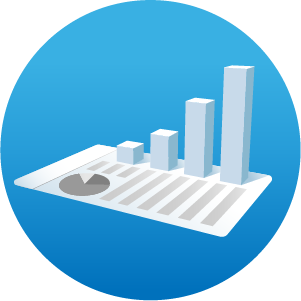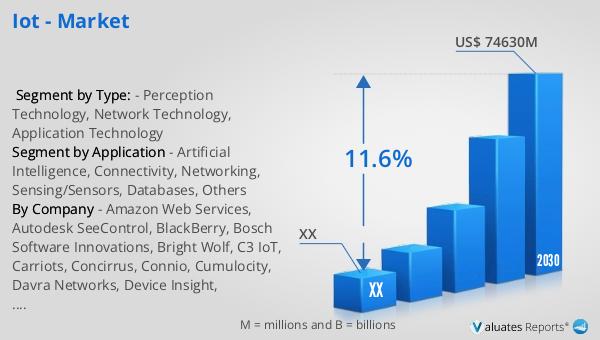List of Tables
Table 1. IoT Market Trends
Table 2. IoT Market Drivers & Opportunity
Table 3. IoT Market Challenges
Table 4. IoT Market Restraints
Table 5. Global IoT Revenue by Company (2019-2024) & (US$ Million)
Table 6. Global IoT Revenue Market Share by Company (2019-2024)
Table 7. Key Companies IoT Manufacturing Base Distribution and Headquarters
Table 8. Key Companies IoT Product Type
Table 9. Key Companies Time to Begin Mass Production of IoT
Table 10. Global IoT Companies Market Concentration Ratio (CR5 and HHI)
Table 11. Global Top Companies Market Share by Company Type (Tier 1, Tier 2, and Tier 3) & (based on the Revenue in IoT as of 2023)
Table 12. Mergers & Acquisitions, Expansion Plans
Table 13. Global IoT Sales Value by Type: 2019 VS 2023 VS 2030 (US$ Million)
Table 14. Global IoT Sales Value by Type (2019-2024) & (US$ Million)
Table 15. Global IoT Sales Value by Type (2025-2030) & (US$ Million)
Table 16. Global IoT Sales Market Share in Value by Type (2019-2024) & (%)
Table 17. Global IoT Sales Market Share in Value by Type (2025-2030) & (%)
Table 18. Global IoT Sales Value by Application: 2019 VS 2023 VS 2030 (US$ Million)
Table 19. Global IoT Sales Value by Application (2019-2024) & (US$ Million)
Table 20. Global IoT Sales Value by Application (2025-2030) & (US$ Million)
Table 21. Global IoT Sales Market Share in Value by Application (2019-2024) & (%)
Table 22. Global IoT Sales Market Share in Value by Application (2025-2030) & (%)
Table 23. Global IoT Sales Value by Region: 2019 VS 2023 VS 2030 (US$ Million)
Table 24. Global IoT Sales Value by Region (2019-2024) & (US$ Million)
Table 25. Global IoT Sales Value by Region (2025-2030) & (US$ Million)
Table 26. Global IoT Sales Value by Region (2019-2024) & (%)
Table 27. Global IoT Sales Value by Region (2025-2030) & (%)
Table 28. Key Countries/Regions IoT Sales Value Growth Trends, (US$ Million): 2019 VS 2023 VS 2030
Table 29. Key Countries/Regions IoT Sales Value, (2019-2024) & (US$ Million)
Table 30. Key Countries/Regions IoT Sales Value, (2025-2030) & (US$ Million)
Table 31. Amazon Web Services Basic Information List
Table 32. Amazon Web Services Description and Business Overview
Table 33. Amazon Web Services IoT Products, Services and Solutions
Table 34. Revenue (US$ Million) in IoT Business of Amazon Web Services (2019-2024)
Table 35. Amazon Web Services Recent Developments
Table 36. Autodesk SeeControl Basic Information List
Table 37. Autodesk SeeControl Description and Business Overview
Table 38. Autodesk SeeControl IoT Products, Services and Solutions
Table 39. Revenue (US$ Million) in IoT Business of Autodesk SeeControl (2019-2024)
Table 40. Autodesk SeeControl Recent Developments
Table 41. BlackBerry Basic Information List
Table 42. BlackBerry Description and Business Overview
Table 43. BlackBerry IoT Products, Services and Solutions
Table 44. Revenue (US$ Million) in IoT Business of BlackBerry (2019-2024)
Table 45. BlackBerry Recent Developments
Table 46. Bosch Software Innovations Basic Information List
Table 47. Bosch Software Innovations Description and Business Overview
Table 48. Bosch Software Innovations IoT Products, Services and Solutions
Table 49. Revenue (US$ Million) in IoT Business of Bosch Software Innovations (2019-2024)
Table 50. Bosch Software Innovations Recent Developments
Table 51. Bright Wolf Basic Information List
Table 52. Bright Wolf Description and Business Overview
Table 53. Bright Wolf IoT Products, Services and Solutions
Table 54. Revenue (US$ Million) in IoT Business of Bright Wolf (2019-2024)
Table 55. Bright Wolf Recent Developments
Table 56. C3 IoT Basic Information List
Table 57. C3 IoT Description and Business Overview
Table 58. C3 IoT IoT Products, Services and Solutions
Table 59. Revenue (US$ Million) in IoT Business of C3 IoT (2019-2024)
Table 60. C3 IoT Recent Developments
Table 61. Carriots Basic Information List
Table 62. Carriots Description and Business Overview
Table 63. Carriots IoT Products, Services and Solutions
Table 64. Revenue (US$ Million) in IoT Business of Carriots (2019-2024)
Table 65. Carriots Recent Developments
Table 66. Concirrus Basic Information List
Table 67. Concirrus Description and Business Overview
Table 68. Concirrus IoT Products, Services and Solutions
Table 69. Revenue (US$ Million) in IoT Business of Concirrus (2019-2024)
Table 70. Concirrus Recent Developments
Table 71. Connio Basic Information List
Table 72. Connio Description and Business Overview
Table 73. Connio IoT Products, Services and Solutions
Table 74. Revenue (US$ Million) in IoT Business of Connio (2019-2024)
Table 75. Connio Recent Developments
Table 76. Cumulocity Basic Information List
Table 77. Cumulocity Description and Business Overview
Table 78. Cumulocity IoT Products, Services and Solutions
Table 79. Revenue (US$ Million) in IoT Business of Cumulocity (2019-2024)
Table 80. Cumulocity Recent Developments
Table 81. Davra Networks Basic Information List
Table 82. Davra Networks Description and Business Overview
Table 83. Davra Networks IoT Products, Services and Solutions
Table 84. Revenue (US$ Million) in IoT Business of Davra Networks (2019-2024)
Table 85. Davra Networks Recent Developments
Table 86. Device Insight Basic Information List
Table 87. Device Insight Description and Business Overview
Table 88. Device Insight IoT Products, Services and Solutions
Table 89. Revenue (US$ Million) in IoT Business of Device Insight (2019-2024)
Table 90. Device Insight Recent Developments
Table 91. EVRYTHNG Basic Information List
Table 92. EVRYTHNG Description and Business Overview
Table 93. EVRYTHNG IoT Products, Services and Solutions
Table 94. Revenue (US$ Million) in IoT Business of EVRYTHNG (2019-2024)
Table 95. EVRYTHNG Recent Developments
Table 96. Exosite Basic Information List
Table 97. Exosite Description and Business Overview
Table 98. Exosite IoT Products, Services and Solutions
Table 99. Revenue (US$ Million) in IoT Business of Exosite (2019-2024)
Table 100. Exosite Recent Developments
Table 101. GE Basic Information List
Table 102. GE Description and Business Overview
Table 103. GE IoT Products, Services and Solutions
Table 104. Revenue (US$ Million) in IoT Business of GE (2019-2024)
Table 105. GE Recent Developments
Table 106. Key Raw Materials Lists
Table 107. Raw Materials Key Suppliers Lists
Table 108. IoT Downstream Customers
Table 109. IoT Distributors List
Table 110. Research Programs/Design for This Report
Table 111. Key Data Information from Secondary Sources
Table 112. Key Data Information from Primary Sources
Table 113. Business Unit and Senior & Team Lead Analysts
List of Figures
Figure 1. IoT Product Picture
Figure 2. Global IoT Sales Value, 2019 VS 2023 VS 2030 (US$ Million)
Figure 3. Global IoT Sales Value (2019-2030) & (US$ Million)
Figure 4. IoT Report Years Considered
Figure 5. Global IoT Players Revenue Ranking (2023) & (US$ Million)
Figure 6. The 5 and 10 Largest Manufacturers in the World: Market Share by IoT Revenue in 2023
Figure 7. IoT Market Share by Company Type (Tier 1, Tier 2, and Tier 3): 2019 VS 2023
Figure 8. Perception Technology Picture
Figure 9. Network Technology Picture
Figure 10. Application Technology Picture
Figure 11. Global IoT Sales Value by Type (2019 VS 2023 VS 2030) & (US$ Million)
Figure 12. Global IoT Sales Value Market Share by Type, 2023 & 2030
Figure 13. Product Picture of Artificial Intelligence
Figure 14. Product Picture of Connectivity
Figure 15. Product Picture of Networking
Figure 16. Product Picture of Sensing/Sensors
Figure 17. Product Picture of Databases
Figure 18. Product Picture of Others
Figure 19. Global IoT Sales Value by Application (2019 VS 2023 VS 2030) & (US$ Million)
Figure 20. Global IoT Sales Value Market Share by Application, 2023 & 2030
Figure 21. North America IoT Sales Value (2019-2030) & (US$ Million)
Figure 22. North America IoT Sales Value by Country (%), 2023 VS 2030
Figure 23. Europe IoT Sales Value (2019-2030) & (US$ Million)
Figure 24. Europe IoT Sales Value by Country (%), 2023 VS 2030
Figure 25. Asia Pacific IoT Sales Value (2019-2030) & (US$ Million)
Figure 26. Asia Pacific IoT Sales Value by Country (%), 2023 VS 2030
Figure 27. South America IoT Sales Value (2019-2030) & (US$ Million)
Figure 28. South America IoT Sales Value by Country (%), 2023 VS 2030
Figure 29. Middle East & Africa IoT Sales Value (2019-2030) & (US$ Million)
Figure 30. Middle East & Africa IoT Sales Value by Country (%), 2023 VS 2030
Figure 31. Key Countries/Regions IoT Sales Value (%), (2019-2030)
Figure 32. United States IoT Sales Value, (2019-2030) & (US$ Million)
Figure 33. United States IoT Sales Value by Type (%), 2023 VS 2030
Figure 34. United States IoT Sales Value by Application (%), 2023 VS 2030
Figure 35. Europe IoT Sales Value, (2019-2030) & (US$ Million)
Figure 36. Europe IoT Sales Value by Type (%), 2023 VS 2030
Figure 37. Europe IoT Sales Value by Application (%), 2023 VS 2030
Figure 38. China IoT Sales Value, (2019-2030) & (US$ Million)
Figure 39. China IoT Sales Value by Type (%), 2023 VS 2030
Figure 40. China IoT Sales Value by Application (%), 2023 VS 2030
Figure 41. Japan IoT Sales Value, (2019-2030) & (US$ Million)
Figure 42. Japan IoT Sales Value by Type (%), 2023 VS 2030
Figure 43. Japan IoT Sales Value by Application (%), 2023 VS 2030
Figure 44. South Korea IoT Sales Value, (2019-2030) & (US$ Million)
Figure 45. South Korea IoT Sales Value by Type (%), 2023 VS 2030
Figure 46. South Korea IoT Sales Value by Application (%), 2023 VS 2030
Figure 47. Southeast Asia IoT Sales Value, (2019-2030) & (US$ Million)
Figure 48. Southeast Asia IoT Sales Value by Type (%), 2023 VS 2030
Figure 49. Southeast Asia IoT Sales Value by Application (%), 2023 VS 2030
Figure 50. India IoT Sales Value, (2019-2030) & (US$ Million)
Figure 51. India IoT Sales Value by Type (%), 2023 VS 2030
Figure 52. India IoT Sales Value by Application (%), 2023 VS 2030
Figure 53. IoT Industrial Chain
Figure 54. IoT Manufacturing Cost Structure
Figure 55. Channels of Distribution (Direct Sales, and Distribution)
Figure 56. Bottom-up and Top-down Approaches for This Report
Figure 57. Data Triangulation


